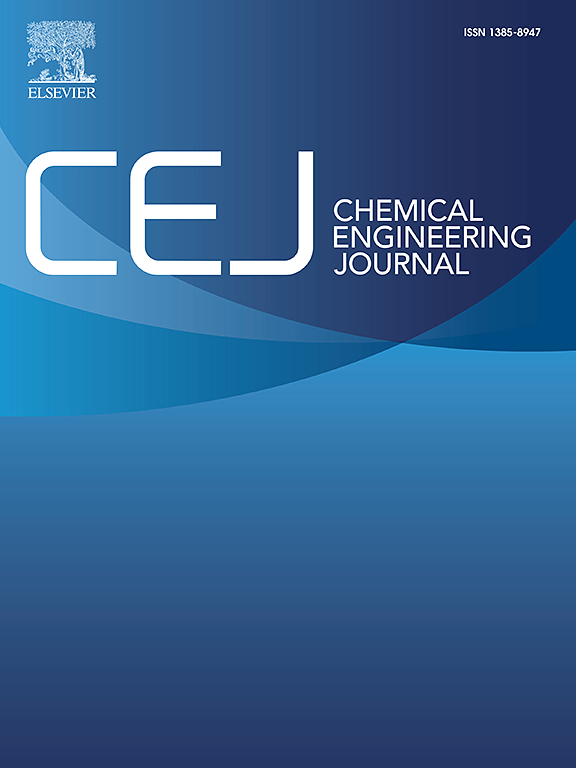Real-time freshness monitoring of fruits and vegetables integrating 3D-printed alginate-based colorimetric sensors with deep convolutional neural networks
IF 13.3
1区 工程技术
Q1 ENGINEERING, CHEMICAL
引用次数: 0
Abstract
3D printing, as an innovative smart label fabrication technology, offers exceptional design flexibility and the ability to integrate diverse materials. In this study, sodium alginate (SA) hydrogel, polyvinyl alcohol (PVA), and glycerol were used as the film-forming matrix (ink), incorporating 12 pH-sensitive indicators. This ink was employed in 3D printing to produce colorimetric sensor arrays with varied layer numbers and fill densities. Considering preparation time, material consumption, and responsiveness to different concentrations of ammonia and acidic solutions, the sensor array with a 100 % + 60 % fill density demonstrated an optimal balance between gas permeability and color change intensity. By integrating these sensor arrays with deep convolutional neural networks (DCNNs), precise classification of microbial growth stages was achieved by detecting acidity and alkalinity changes in volatile metabolite gases produced during microbial growth. The MobileNetV2 model attained a classification accuracy of 81.41 % for E. coli, while the ShuffleNet and Xception models achieved 98.74 % accuracy for B. cereus. Moreover, these colorimetric sensor arrays with varying pH sensitivities were applied to monitor freshness changes in fruits and vegetables during storage. Results showed significant color changes within the first 48 h for strawberries, raspberries, Malanto, and soybean sprouts, after which colors stabilized. In mulberries, a sharp pH drop during the later spoilage phase induced the most pronounced color change. On day 2 of storage at 25 °C, the E sensor label on mulberries exhibited a color difference of 118.85, 6.77 times higher than that of the control group. Additionally, the H sensor label's color differences increased from 87.92 to 202.88 over days 2, 4, and 6, indicating a gradual formation of a strongly acidic environment inside the packaging. The trained MobileNetV2 model achieved freshness classification accuracies of 97.95 %, 99.49 %, 95.90 %, 97.44 %, and 93.85 % for strawberries, mulberries, raspberries, Malanto, and soybean sprouts stored at 4 °C, respectively, in the test set. This study presents an innovative, real-time monitoring solution for fruit and vegetable preservation and quality control.

结合3d打印海藻酸盐比色传感器和深度卷积神经网络的水果和蔬菜实时新鲜度监测
3D打印作为一种创新的智能标签制造技术,提供了卓越的设计灵活性和整合多种材料的能力。本研究以海藻酸钠(SA)水凝胶、聚乙烯醇(PVA)和甘油为成膜基质(油墨),加入12种ph敏感指示剂。这种油墨被用于3D打印,以生产具有不同层数和填充密度的比色传感器阵列。考虑到制备时间、材料消耗以及对不同浓度氨和酸性溶液的响应性,填充密度为100 % + 60 %的传感器阵列在透气性和颜色变化强度之间达到了最佳平衡。通过将这些传感器阵列与深度卷积神经网络(DCNNs)相结合,通过检测微生物生长过程中挥发性代谢物气体的酸度和碱度变化,实现了微生物生长阶段的精确分类。MobileNetV2模型对大肠杆菌的分类准确率为81.41 %,而ShuffleNet和Xception模型对蜡样芽孢杆菌的分类准确率为98.74 %。此外,这些具有不同pH灵敏度的比色传感器阵列应用于监测水果和蔬菜在储存期间的新鲜度变化。结果表明,草莓、覆盆子、马兰托和豆芽在前48 h内颜色发生了显著变化,之后颜色稳定下来。在桑葚中,在变质后期pH值的急剧下降引起了最明显的颜色变化。在25 °C条件下储存第2天,桑葚E传感器标签的色差为118.85,是对照组的6.77倍。此外,H传感器标签的色差在第2、4和6天内从87.92增加到202.88,表明包装内逐渐形成强酸性环境。经过训练的MobileNetV2模型在测试集中对储存在4 °C的草莓、桑葚、树莓、马兰托和大豆芽的新鲜度分类准确率分别为97.95 %、99.49 %、95.90 %、97.44 %和93.85 %。本研究为果蔬保鲜和质量控制提供了一种创新的实时监测解决方案。
本文章由计算机程序翻译,如有差异,请以英文原文为准。
求助全文
约1分钟内获得全文
求助全文
来源期刊

Chemical Engineering Journal
工程技术-工程:化工
CiteScore
21.70
自引率
9.30%
发文量
6781
审稿时长
2.4 months
期刊介绍:
The Chemical Engineering Journal is an international research journal that invites contributions of original and novel fundamental research. It aims to provide an international platform for presenting original fundamental research, interpretative reviews, and discussions on new developments in chemical engineering. The journal welcomes papers that describe novel theory and its practical application, as well as those that demonstrate the transfer of techniques from other disciplines. It also welcomes reports on carefully conducted experimental work that is soundly interpreted. The main focus of the journal is on original and rigorous research results that have broad significance. The Catalysis section within the Chemical Engineering Journal focuses specifically on Experimental and Theoretical studies in the fields of heterogeneous catalysis, molecular catalysis, and biocatalysis. These studies have industrial impact on various sectors such as chemicals, energy, materials, foods, healthcare, and environmental protection.
 求助内容:
求助内容: 应助结果提醒方式:
应助结果提醒方式:


